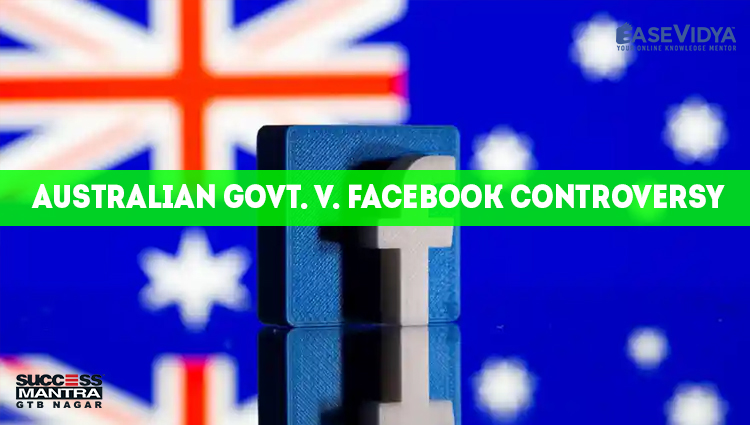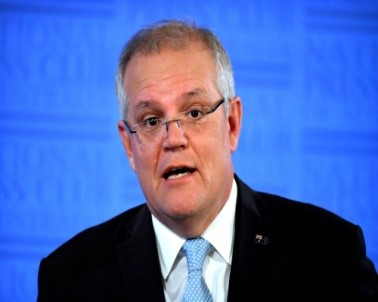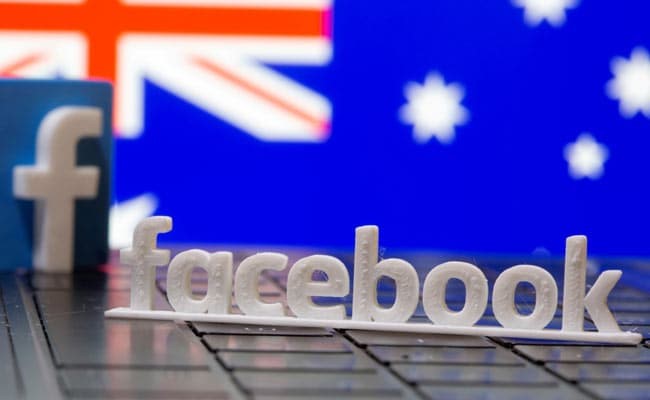
AUSTRALIAN GOVT V FACEBOOK CONTROVERSY
AUSTRALIAN GOVT. V. FACEBOOK CONTROVERSY

Australia has reached out to India among several countries, including Canada, France and the UK, in a move to stitch a global coalition against tech giants Google and Facebook amid a faceoff over compensation for sharing news content from media companies on their platforms.
Australia’s proposed law, News Media and Digital Platforms Mandatory Bargaining Code Bill 2020, mandates a bargaining code that aims to force Google and Facebook to compensate media companies for using their content. The Bill is expected to set a precedent in regulating social media across geographies.
BACKGROUND OF THE ISSUE

The Australian Competition and Consumer Commission (ACCC), in its 2019 report, Digital Platforms Inquiry, noted that there was a fundamental imbalance in the power between news media and internet platforms. Specifically mentioning Google and Facebook, the report said these platforms had “substantial bargaining power in relation to many news media businesses.” It highlighted that media regulation hardly applied to platforms, though they have been increasingly playing much the same role as the media. The last two decades have also seen the tremendous rise of the platforms and sharp decline of the traditional news media. The Australian government, reportedly sensing how important it was to have a strong and independent media environment in a democracy, asked the ACCC to come up with a draft code, which it did in July 2020. After some changes, the Treasury Laws Amendment (News Media and Digital Platforms Mandatory Bargaining Code) Bill was introduced in December 2020.
AUSTRALIA'S MEDIA PLATFORM BILL
Payment to News Outlets: Big tech and social media giants like Facebook and Google will have to pay local news outlets for using their content. Big Tech firms will have to negotiate how much they pay local publishers and broadcasters for content that appears on their platforms.
Provision of Arbitration and Fine: An arbiter is mandated to adjudicate if no agreement is reached and there are also provisions of heavy fines if agreements are not done.
The Issue Involved: The media industry is already benefiting from traffic routed to them by the digital platforms, and that the proposed rules would expose the Internet companies to “unmanageable levels of financial and operational risk”. Journalism is a public good and a pillar of democracy. Digital platforms piggyback on its content without sharing the associated costs. The subsequent diversion of advertising revenue has undermined traditional media, particularly regional newspapers. Paying for news feed in itself appears to be less of an issue for the tech giants, given that Google agreed to pay news publications in France. Google signed a deal with a group of French publishers to make digital copyright payments for online news content. The fight in Australia is in fact, centred on how much control these companies would be able to retain on their payout process - operational aspects such as deciding the quantum of payments for news feed sources, and having to reveal changes in their algorithms. France has specifically linked payments to copyright, without putting a forcing device into the agreements. Australia’s code, on the other hand, is almost entirely focused on the bargaining power of news outlets vis-à-vis the tech majors, and has some coercive features as well.
Paying for news feed in itself appears to be less of an issue for the tech giants, given that Google agreed to pay news publications in France just hours before threatening to remove its search functions in Australia. The fight in Australia is in fact, centred on how much control these companies would be able to retain on their payout process — operational aspects such as deciding the quantum of payments for news feed sources, and having to reveal changes in their algorithms.
European authorities have specifically linked payments to copyright, without putting a forcing device into the agreements. Australia’s code, on the other hand, is almost entirely focused on the bargaining power of news outlets vis-à-vis the tech majors, and has some coercive features as well. It is more of a competition issue in Australia, of power equations between traditional news outlets and tech platforms, with the question of abuse of dominance by the latter hanging in the balance.
THE CASE OF INDIA

Policymakers have so far focused on the dominance of intermediaries such as Google and Facebook, which are positioned in a way that service providers cannot reach customers except through these platforms. A substantial discussion on the impact of intermediary platforms on the health of news media outlets is yet to begin in any meaningful way. According to a FICCI-EY report for 2020, there are 300 million users of online news sites, portals and aggregators in the country.
It makes up approximately 46% of Internet users and 77% of smartphone users in India at the end of 2019. With 282 million unique visitors, India is the second largest online news consuming nation after China. In India, digital advertising spends in 2019 grew 24% year-on-year to Rs. 27,900 crore, according to EY estimates, and are expected to grow to Rs. 51,340 crore by 2022. In India, the news aggregators are not mandated to make payments to publishers. News aggregator is an online platform or a software device that collects news stories and other information as that information is published and organizes the information in a specific manner.
CONCLUSION
India presents a unique media market which reflects the country’s diversity. For example, media platforms span multiple languages. Therefore, while the Australian development is of special importance to India, it need not provide an ideal template for the way forward. Digital platforms have brought about huge social gains by democratising access. However, their growing size and revenue models have also had adverse effects, such as spread of fake news. It is this fallout that governments should try to mitigate, to safeguard democracy.
QUESTIONS (1-5)
Q.1 Which of the following is the recently proposed bill by the Australian Government against tech giants such as Google and Facebook?
- Australian Digital platform Regulation Bill 2020
- News Media and Digital Platforms Mandatory Bargaining Code Bill 2020
- OTT platforms regulation and Amendment code Bill, 2020
- None of the above
Q.2 Consider the following statements and state which of the following is incorrect in the reference to the above mentioned passage?
- Australian Competition and Consumer Commission (ACCC), noted that there was a fundamental imbalance in the power between news media and internet platforms.
- Australia has reached out to India among several countries, including Canada, France and the UK, in a move to stitch a global coalition against tech giants Google and Facebook.
- Only I follows
- Only II follows
- Both I & II follows: ANSWER
- None of the above follows
Q.3 What is the name of the IT law that India is having in the Indian legislature?
- India’s Technology (IT) Act, 2000
- India’s Digital Information Technology (DIT) Act, 2000.
- The Technology Act, 2008
- India’s Information Technology (IT) Act, 2000: ANSWER
Q.4 Which of the following statements is/are correct in the context of the OTT & digital platforms regulation in India?
- Legal Recognition to Digital Signatures, Regulation of Certification Authorities, Digital Certificates all are components of IT Act 2000.
- India's government has issued an order bringing the regulation of online news portals and content providers such as Netflix under the authority of the Ministry of Information and Broadcasting.
- There are altogether 6 schedules under the IT ACT 2000.
- I & III follows
- II & III follows
- I & II follows: ANSWER
- None of the above













0 Comment